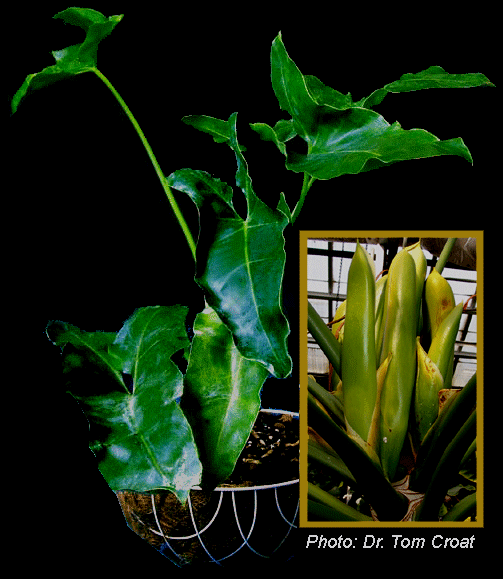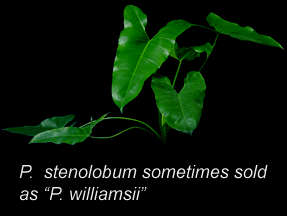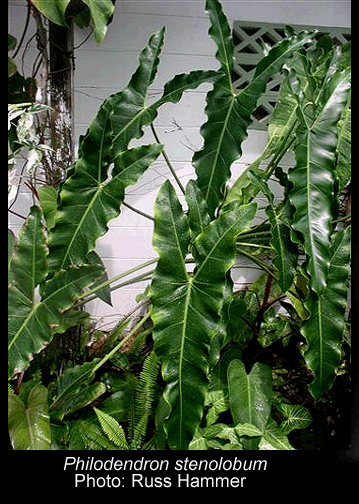![]()
Aroids and other genera in the Collection
Take the Tour Now?
Orchids
The
Exotic Rainforest
Plants in
the Exotic Rainforest Collection
The images on this website are copyright protected. Please contact us before any reuse.
In depth information on
how to grow Philodendron
species, Click this Link
Within our collection we have many species of Philodendron. If you are seeking other photos, click this link:
Philodendron stenolobum
E.G.
Gonçalves

Often sold incorrectly as "Philodendron willamsii"
Some sources have tried to claim this species is a hybrid, however, both TROPICOS (Missouri Botanical Garden) and the International Plant Names Index indicate it is a recognized and published Brazilian species. Philodendron stenolobum was described to science by Dr. Eduardo Gonçalves (gon-ZAL-vas), the very well known Brazilian botanical expert.
 The plant has long wavy narrow leaves that average 2 to 3
feet (60cm to 90cm) in length and can be approximately 1 foot
(30cm) wide in one of the collected variations. P. stenolobum
has glossy leaf surfaces and there are several varieties of the species
sometimes offered for sale. One (not the one shown in my photo) has
much narrower and even more wavy leaf blades and
another shows little resemblance to either (see below).
Yet, they are the same species, simply different forms. Philodendron species,
and especially hybrid forms, are
known to be highly variable and not every leaf of every specimen
will always appear the same. This link explains in greater
detail the scientific principle of natural variation and
morphogenesis.
Click
here.
The plant has long wavy narrow leaves that average 2 to 3
feet (60cm to 90cm) in length and can be approximately 1 foot
(30cm) wide in one of the collected variations. P. stenolobum
has glossy leaf surfaces and there are several varieties of the species
sometimes offered for sale. One (not the one shown in my photo) has
much narrower and even more wavy leaf blades and
another shows little resemblance to either (see below).
Yet, they are the same species, simply different forms. Philodendron species,
and especially hybrid forms, are
known to be highly variable and not every leaf of every specimen
will always appear the same. This link explains in greater
detail the scientific principle of natural variation and
morphogenesis.
Click
here.
This Philodendron is
generally known to collectors as a self header and is thought by some not to
be a climber. Information from Leland Miyano in Hawaii will
quickly destroy that theory! Leland recently wrote,
"Two of
mine have at least 20 feet of trunk."
Leland then adds this note regarding specimens he personally
collected in Brazil,
"I have them
growing up Ficus pseudopalma.
I
have several different clones from several sites from Espirito Santo
to Southern Bahia. They have odd thorn-like projections on the
aerial roots."
Leland states the trunk of his specimens is approximately 4.5 inches
(11.5cm) thick.
 According to Dr. Gonçalves' technical description
the plant is actually a hemiepiphyte (hem-a-EPA-fit). That group of
plants is epiphytic for one portion of its growth but becomes rooted
in the soil during another stage. A primary hemiepiphyte
begins as an epiphyte (ep-a-FIT) growing on trees and later becomes rooted in
soil, while a secondary hemiepiphyte begins life rooted in
soil and later becomes an epiphytic plant form. Dr. Gonçalves reports
the plant is hemiepiphytic in forests but "occasionally" becomes
terrestrial in open areas. Since Dr. Gonçalves
reports it is capable of growing without the support of a tree in
open terrain this species would appear to be secondary.
According to Dr. Gonçalves' technical description
the plant is actually a hemiepiphyte (hem-a-EPA-fit). That group of
plants is epiphytic for one portion of its growth but becomes rooted
in the soil during another stage. A primary hemiepiphyte
begins as an epiphyte (ep-a-FIT) growing on trees and later becomes rooted in
soil, while a secondary hemiepiphyte begins life rooted in
soil and later becomes an epiphytic plant form. Dr. Gonçalves reports
the plant is hemiepiphytic in forests but "occasionally" becomes
terrestrial in open areas. Since Dr. Gonçalves
reports it is capable of growing without the support of a tree in
open terrain this species would appear to be secondary.
That terrestrial growth form in open areas has led the philodendron to be known by collectors as a "tree philodendron" that grows a thick "trunk" as it gets larger with a plant height (according to collectors) of 18" (46cm) to 4 feet (120cm). Florida plant collector Russ Hammer has reported in a personal email his self supporting specimen was taller than 4 feet (120cm). According to Dr. Gonçalves' published report and the information regarding Leland's plants in Hawaii the species is certainly not strictly a "tree" philodendron as some reports have claimed!
Philodendron stenolobum is sometimes sold as P. willamsii
in the plant trade and was thought by some to be a narrow
leaf form of P.
williamsii. These species are not one and the same. The true Philodendron williamsii
has
shorter, broader leaves and is not as attractive a plant as
P. stenolobum. There are distinct differences in
the two species. Many forms sold as P. williamsii
(including the specimen shown to the right) are simply variations of
P. stenolobum according to Dr. Gonçalves. Click here to
see
that plant on
 this website
this website
The inset photo of a cluster of spathes (above) was provided by Dr. Tom Croat of the Missouri Botanical Garden. Dr. Croat's specimen is quite large in comparison to our specimen. However, in the year since our specimen was photographed it has more than doubled in size and height.
We grow our specimen in reasonably bright light that is only sometimes shaded. The plant is in very well draining soil mixed with peat, orchid bark and Perlite™. My thanks to Julius Boos for his input into the research on this species
If you are seeking information on
other rare species, click on "Aroids and other genera in the Collection" at the top
and look for the
Want to learn more
about aroids?
Join the
International Aroid Society:
http://www.exoticrainforest.com/Join%20IAS.html
Looking for a specimen? Contact
http:///
![]()